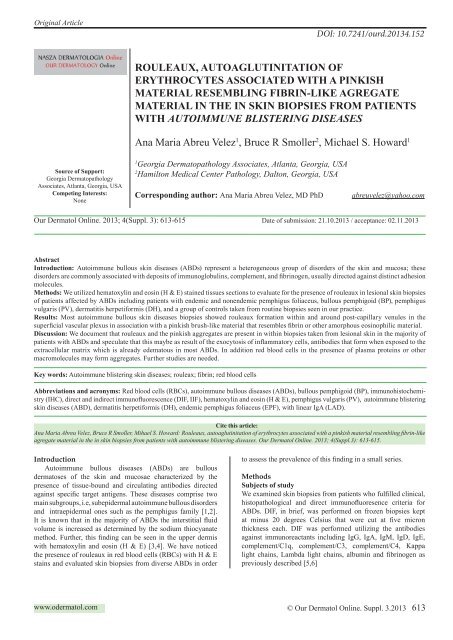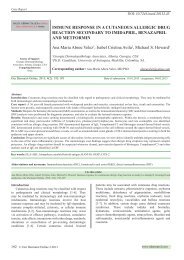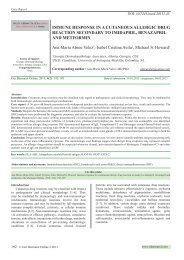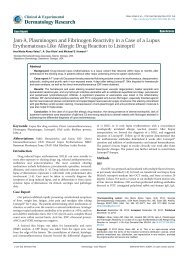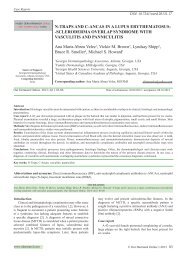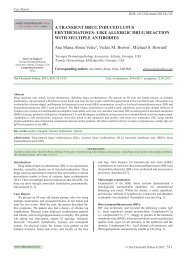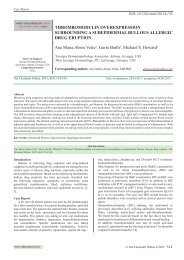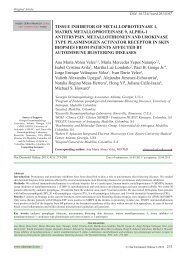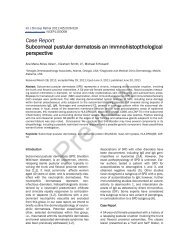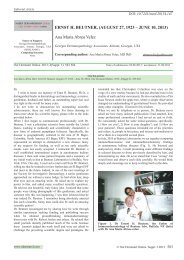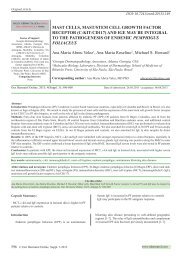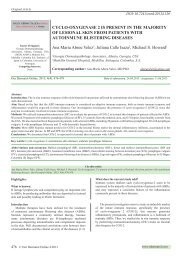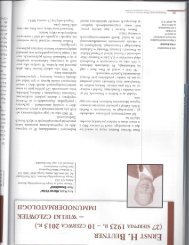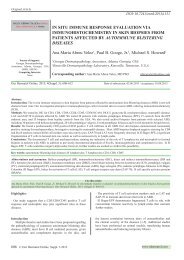o_195eg5um619bmagfkf912fcpb9a.pdf
Create successful ePaper yourself
Turn your PDF publications into a flip-book with our unique Google optimized e-Paper software.
Original Article<br />
DOI: 10.7241/ourd.20134.152<br />
ROULEAUX, AUTOAGLUTINITATION OF<br />
ERYTHROCYTES ASSOCIATED WITH A PINKISH<br />
MATERIAL RESEMBLING FIBRIN-LIKE AGREGATE<br />
MATERIAL IN THE IN SKIN BIOPSIES FROM PATIENTS<br />
WITH AUTOIMMUNE BLISTERING DISEASES<br />
Ana Maria Abreu Velez 1 , Bruce R Smoller 2 , Michael S. Howard 1<br />
Source of Support:<br />
Georgia Dermatopathology<br />
Associates, Atlanta, Georgia, USA<br />
Competing Interests:<br />
None<br />
1<br />
Georgia Dermatopathology Associates, Atlanta, Georgia, USA<br />
2<br />
Hamilton Medical Center Pathology, Dalton, Georgia, USA<br />
Corresponding author: Ana Maria Abreu Velez, MD PhD<br />
abreuvelez@yahoo.com<br />
Our Dermatol Online. 2013; 4(Suppl. 3): 613-615 Date of submission: 21.10.2013 / acceptance: 02.11.2013<br />
Abstract<br />
Introduction: Autoimmune bullous skin diseases (ABDs) represent a heterogeneous group of disorders of the skin and mucosa; these<br />
disorders are commonly associated with deposits of immunoglobulins, complement, and fibrinogen, usually directed against distinct adhesion<br />
molecules.<br />
Methods: We utilized hematoxylin and eosin (H & E) stained tissues sections to evaluate for the presence of rouleaux in lesional skin biopsies<br />
of patients affected by ABDs including patients with endemic and nonendemic pemphigus foliaceus, bullous pemphigoid (BP), pemphigus<br />
vulgaris (PV), dermatitis herpetiformis (DH), and a group of controls taken from routine biopsies seen in our practice.<br />
Results: Most autoimmune bullous skin diseases biopsies showed rouleaux formation within and around post-capillary venules in the<br />
superficial vascular plexus in association with a pinkish brush-like material that resembles fibrin or other amorphous eosinophilic material.<br />
Discussion: We document that rouleaux and the pinkish aggregates are present in within biopsies taken from lesional skin in the majority of<br />
patients with ABDs and speculate that this maybe as result of the exocytosis of inflammatory cells, antibodies that form when exposed to the<br />
extracellular matrix which is already edematous in most ABDs. In addition red blood cells in the presence of plasma proteins or other<br />
macromolecules may form aggregates. Further studies are needed.<br />
Key words: Autoimmune blistering skin diseases; rouleax; fibrin; red blood cells<br />
Abbreviations and acronyms: Red blood cells (RBCs), autoimmune bullous diseases (ABDs), bullous pemphigoid (BP), immunohistochemistry<br />
(IHC), direct and indirect immunofluorescence (DIF, IIF), hematoxylin and eosin (H & E), pemphigus vulgaris (PV), autoimmune blistering<br />
skin diseases (ABD), dermatitis herpetiformis (DH), endemic pemphigus foliaceus (EPF), with linear IgA (LAD).<br />
Cite this article:<br />
Ana Maria Abreu Velez, Bruce R Smoller, Mihael S. Howard: Rouleaux, autoaglutinitation of erythrocytes associated with a pinkish material resembling fibrin-like<br />
agregate material in the in skin biopsies from patients with autoimmune blistering diseases. Our Dermatol Online. 2013; 4(Suppl.3): 613-615.<br />
Introduction<br />
Autoimmune bullous diseases (ABDs) are bullous<br />
dermatoses of the skin and mucosae characterized by the<br />
presence of tissue-bound and circulating antibodies directed<br />
against specific target antigens. These diseases comprise two<br />
main subgroups, i.e, subepidermal autoimmune bullous disorders<br />
and intraepidermal ones such as the pemphigus family [1,2].<br />
It is known that in the majority of ABDs the interstitial fluid<br />
volume is increased as determined by the sodium thiocyanate<br />
method. Further, this finding can be seen in the upper dermis<br />
with hematoxylin and eosin (H & E) [3,4]. We have noticed<br />
the presence of rouleaux in red blood cells (RBCs) with H & E<br />
stains and evaluated skin biopsies from diverse ABDs in order<br />
to assess the prevalence of this finding in a small series.<br />
Methods<br />
Subjects of study<br />
We examined skin biopsies from patients who fulfilled clinical,<br />
histopathological and direct immunofluoresence criteria for<br />
ABDs. DIF, in brief, was performed on frozen biopsies kept<br />
at minus 20 degrees Celsius that were cut at five micron<br />
thickness each. DIF was performed utilizing the antibodies<br />
against immunoreactants including IgG, IgA, IgM, IgD, IgE,<br />
complement/C1q, complement/C3, complement/C4, Kappa<br />
light chains, Lambda light chains, albumin and fibrinogen as<br />
previously described [5,6]<br />
www.odermatol.com<br />
© Our Dermatol Online. Suppl. 3.2013 613
We examined 30 biopsies from patients affected by endemic<br />
pemphigus foliaceus (EPF) and 20 skin biopsies from normal<br />
controls (patients without EPF) from the EPF endemic area<br />
(NCEA). We also utilized 30 control skin biopsies from healthy<br />
plastic surgery reduction patients, taken from the chest and/<br />
or abdomen normal human skin in the local population (south<br />
eastern USA) (NHS). Biopsies were fixed in 10% buffered<br />
formalin, then embedded in paraffin and cut at 4 micron<br />
thicknesses. The tissue was then stained with H & E. All<br />
patients were having primary diagnostic biopsies, and were not<br />
taking immunosuppressive therapeutic medications at the time<br />
of biopsy. We evaluated 20 biopsies from bullous pemphigoid<br />
(BP) patients, 20 from patients with pemphigus vulgaris (PV),<br />
eight patient biopsies with pemphigus foliaceus (PF), 12 from<br />
patients with dermatitis herpetiformis (DH) and one with linear<br />
IgA (LAD). The archival biopsies were IRB exempt due to the<br />
lack of patient identifiers.<br />
Result<br />
Rouleaux, erythrocytes and some type of autoagglutinitation<br />
of RBCs and the presence of a pinkish brush-like material that<br />
resembles fibrinoid aggregates were positive in 24/30 biopsies<br />
from EPF, in 17/20 patients with BP, in 16/20 in patients with<br />
PV, in 10/12 patients with DH, and in the only LAD patient.<br />
30/30 NHS and 15/15 NCEA normal controls skin biopsies<br />
failed to demonstrate the finding. The rouleaux, the aggregated<br />
RBCs and the pinkish material were uniformly seen under the<br />
blisters in most ABDs, and or under the inflamed vessel were<br />
close to the blisters (Fig. 1, 2).<br />
Figure 1 and 2. Shows representative H & E stain in the different ABDs showing the presence of rouleux, individuals and<br />
agglutinned erythrocytes with the pinkish material in the upper dermis close to the blisters black arrows (20X).<br />
Discussion<br />
In several ABDs, it has been reported that the number<br />
of erythrocytes, hematocrit and the amount of hemoglobin<br />
decreases in patients with advanced autoimmune bullous<br />
diseases, mainly in the pemphigus group [4,7]. Rouleaux<br />
are a linear arrangement of red blood cells (RBC) sometimes<br />
known as having a „coinstack” configuration. This phenomenon<br />
has been associated with increased fibrinogen, globulins, or<br />
paraproteins [8-10]. The serum of patients with ABDs is rich<br />
in circulating autoantibodies as well as fibrinogen and these are<br />
usually deposited in lesional skin in most ABDs patients [3].<br />
Roulex also occur in acute and chronic inflammatory disorders,<br />
Waldenstrom’s macroglobulinemia and multiple myeloma<br />
[2-5]. RBCs in the presence of plasma proteins or other<br />
macromolecules may form aggregates, normally in rouleaux<br />
formations, which are dispersed with increasing blood flow [8-<br />
10].<br />
Based on our findings of rouleaux, the pinkish material, the<br />
dilatation and/or alteration of the vessels proximal to blisters<br />
in association with the presence of inflammation, we believe<br />
that the formation of rouleax results from flow and permeability<br />
alterations. It is also possible that the endothelial cells lose some<br />
of their strict regulation due to the adjacent tissue damage,<br />
especially beneath the blisters. All these changes may result in<br />
the sudden release of inflammatory cells, RBCs, fibronectine,<br />
fibrin and other materials that get mixed with some of the<br />
acantholytic cells, cells altering that microbalance. The plasma<br />
proteins in various ABDs have been described to be altered<br />
[11]. This may produce alterations in the blood flow, and may<br />
result in rouleaux formation, with or without autoagglutination,<br />
clumpled with lysed cells and extravasation of molecules.<br />
Electron microscopy studies demonstrated that in most ABDs<br />
the blood vessels show alterations indicative of an outward<br />
passage of fluid and the adjacent dermal, and edema separating<br />
collagen fibers of the collagen bundles [12,13].<br />
614 © Our Dermatol Online. Suppl. 3.2013
The presence of erythrocytes outside the upper vessels and<br />
under and or inside the blister could not be attributed solely to<br />
procedural trauma caused by the biopsy. If this were the case<br />
we would see them in the periphery of the biopsy and in the<br />
cases examined, these findings were in the central portions of<br />
the biopsy specimens.<br />
To the best of our knowledge, this is the first report of rouleaux/<br />
and /or autoagglutination in the series of lesional skin biopsies<br />
taken from patients with ABDs. The significance of these<br />
findings is a topic for a more intense and thorough investigation.<br />
REFERENCES<br />
1. Daneshpazhooh M, Chams-Davatchi C, Payandemehr P, Nassiri<br />
S, Valikhani M, Safai-Naraghi Z: Spectrum of autoimmune bullous<br />
diseases in Iran: a 10-year review. Int J Dermatol. 2012;51:35-41.<br />
2. Beutner EH, Jordon RE, Chorzelski TP: The immunopathology of<br />
pemphigus and bullous pemphigoid. J Invest Dermatol. 1989;92(4<br />
Suppl):166S.<br />
3. Grandall LA, Jr, Anderson MX: Estimation of the state of hydration<br />
of the body by the amount of water available for the solution of<br />
sodium thiocyanate. Am J Digest Dis Nutrition. 1934;1:126.<br />
4. Kandhari KC, Pasricha JS: A study of proteins and electrolytes of<br />
serum and blister fluid in pemphigus. J Invest Dermatol. 1965;44:246-<br />
51.<br />
5. Abreu-Velez AM, Klein AD, Howard MS: Skin appendageal<br />
immune reactivity in a case of cutaneous lupus. Our Dermatol<br />
Online. 2011;2:175-80.<br />
6. Abreu Velez AM, Jackson B, Howard MS: Deposition of<br />
immunoreactants in a cutaneous allergic drug reaction. North Am J<br />
Med Sci. 2009;1:180-3.<br />
7. Fisher I: Pemphigus vulgaris. A clinical and laboratory study.<br />
AMA Arch Derm Syphilol. 1952;66:49-58.<br />
8. Barshtein GD Wajnblum D, Yedgar S: Kinetics of linear rouleaux<br />
formation studied by visual monitoring of red cell dynamic<br />
organization. Biophys J. 2000;78:2470–4.<br />
9. Samsel RW, Perelson AS: Kinetics of rouleau formation. II.<br />
Reversible reactions. Biophys J. 1984;45:805-24.<br />
10. Stoltz JF, Donner M: Erythrocyte aggregation: experimental<br />
approaches and clinical implications. Int Angiol. 1987;6:193-201.<br />
11. Lever WF, Schultz EL, Hurley NA: Plasma proteins in various<br />
diseases of the skin; electrophoretic studies. AMA Arch Derm<br />
Syphilol. 1951;63:702-28.<br />
12. Charles A: Electron microscopic observations on pemphigoid.<br />
Brit J Dermat.1960;72:439.<br />
13. Wilgram GF, Caulfield JB, Lever WF: An electron microscopic<br />
study of acantholysis in pemphigus vulgaris. J Invest Dermatol.<br />
1961;36:373-82.<br />
Copyright by Ana Maria Abreu Velez, et al. This is an open access article distributed under the terms of the Creative Commons Attribution License,<br />
which permits unrestricted use, distribution, and reproduction in any medium, provided the original author and source are credited.<br />
© Our Dermatol Online. Suppl. 3.2013 615


